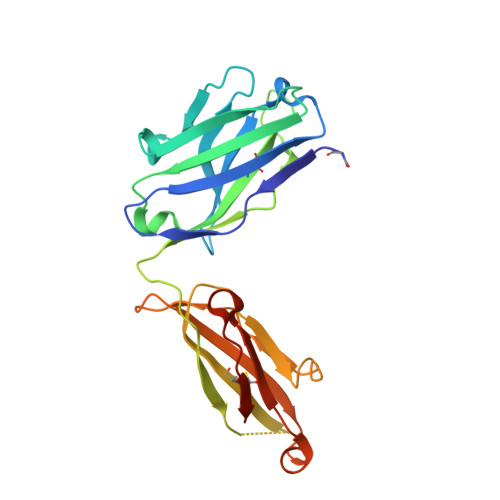Somatic Mutations of the Immunoglobulin Framework Are Generally Required for Broad and Potent HIV-1 Neutralization.
Klein, F., Diskin, R., Scheid, J.F., Gaebler, C., Mouquet, H., Georgiev, I.S., Pancera, M., Zhou, T., Incesu, R.B., Fu, B.Z., Gnanapragasam, P.N., Oliveira, T.Y., Seaman, M.S., Kwong, P.D., Bjorkman, P.J., Nussenzweig, M.C.(2013) Cell 153: 126-138
- PubMed: 23540694
- DOI: https://doi.org/10.1016/j.cell.2013.03.018
- Primary Citation of Related Structures:
4GW4, 4JPV, 4JPW - PubMed Abstract:
Broadly neutralizing antibodies (bNAbs) to HIV-1 can prevent infection and are therefore of great importance for HIV-1 vaccine design. Notably, bNAbs are highly somatically mutated and generated by a fraction of HIV-1-infected individuals several years after infection. Antibodies typically accumulate mutations in the complementarity determining region (CDR) loops, which usually contact the antigen. The CDR loops are scaffolded by canonical framework regions (FWRs) that are both resistant to and less tolerant of mutations. Here, we report that in contrast to most antibodies, including those with limited HIV-1 neutralizing activity, most bNAbs require somatic mutations in their FWRs. Structural and functional analyses reveal that somatic mutations in FWR residues enhance breadth and potency by providing increased flexibility and/or direct antigen contact. Thus, in bNAbs, FWRs play an essential role beyond scaffolding the CDR loops and their unusual contribution to potency and breadth should be considered in HIV-1 vaccine design.
Organizational Affiliation:
Laboratory of Molecular Immunology, The Rockefeller University, New York, NY 10065, USA.

















